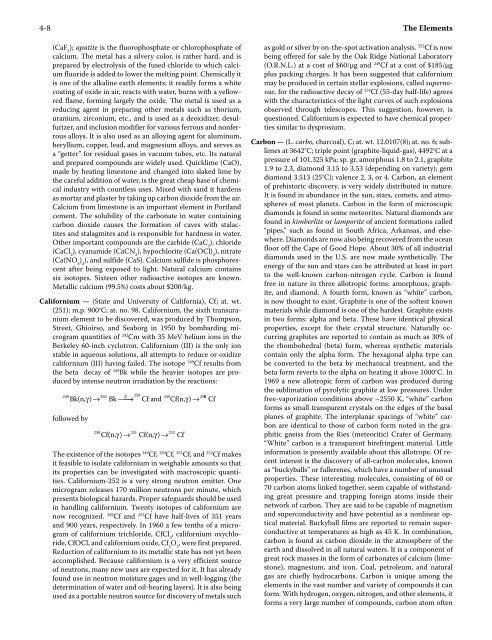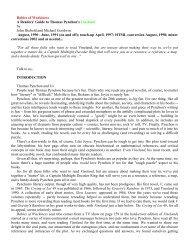CRC Handbook of Chemistry and Physics, 86th Edition
CRC Handbook of Chemistry and Physics, 86th Edition
CRC Handbook of Chemistry and Physics, 86th Edition
You also want an ePaper? Increase the reach of your titles
YUMPU automatically turns print PDFs into web optimized ePapers that Google loves.
4-8 The Elements<br />
(CaF 2 ); apatite is the fluorophosphate or chlorophosphate <strong>of</strong><br />
calcium. The metal has a silvery color, is rather hard, <strong>and</strong> is<br />
prepared by electrolysis <strong>of</strong> the fused chloride to which calcium<br />
fluoride is added to lower the melting point. Chemically it<br />
is one <strong>of</strong> the alkaline earth elements; it readily forms a white<br />
coating <strong>of</strong> oxide in air, reacts with water, burns with a yellowred<br />
flame, forming largely the oxide. The metal is used as a<br />
reducing agent in preparing other metals such as thorium,<br />
uranium, zirconium, etc., <strong>and</strong> is used as a deoxidizer, desulfurizer,<br />
<strong>and</strong> inclusion modifier for various ferrous <strong>and</strong> nonferrous<br />
alloys. It is also used as an alloying agent for aluminum,<br />
beryllium, copper, lead, <strong>and</strong> magnesium alloys, <strong>and</strong> serves as<br />
a “getter” for residual gases in vacuum tubes, etc. Its natural<br />
<strong>and</strong> prepared compounds are widely used. Quicklime (CaO),<br />
made by heating limestone <strong>and</strong> changed into slaked lime by<br />
the careful addition <strong>of</strong> water, is the great cheap base <strong>of</strong> chemical<br />
industry with countless uses. Mixed with s<strong>and</strong> it hardens<br />
as mortar <strong>and</strong> plaster by taking up carbon dioxide from the air.<br />
Calcium from limestone is an important element in Portl<strong>and</strong><br />
cement. The solubility <strong>of</strong> the carbonate in water containing<br />
carbon dioxide causes the formation <strong>of</strong> caves with stalactites<br />
<strong>and</strong> stalagmites <strong>and</strong> is responsible for hardness in water.<br />
Other important compounds are the carbide (CaC 2 ), chloride<br />
(CaCl 2 ), cyanamide (CaCN 2 ), hypochlorite (Ca(OCl) 2 ), nitrate<br />
(Ca(NO 3 ) 2 ), <strong>and</strong> sulfide (CaS). Calcium sulfide is phosphorescent<br />
after being exposed to light. Natural calcium contains<br />
six isotopes. Sixteen other radioactive isotopes are known.<br />
Metallic calcium (99.5%) costs about $200/kg.<br />
Californium — (State <strong>and</strong> University <strong>of</strong> California), Cf; at. wt.<br />
(251); m.p. 900°C; at. no. 98. Californium, the sixth transuranium<br />
element to be discovered, was produced by Thompson,<br />
Street, Ghioirso, <strong>and</strong> Seaborg in 1950 by bombarding microgram<br />
quantities <strong>of</strong> 242 Cm with 35 MeV helium ions in the<br />
Berkeley 60-inch cyclotron. Californium (III) is the only ion<br />
stable in aqueous solutions, all attempts to reduce or oxidize<br />
californium (III) having failed. The isotope 249 Cf results from<br />
the beta decay <strong>of</strong> 249 Bk while the heavier isotopes are produced<br />
by intense neutron irradiation by the reactions:<br />
249<br />
250 β 250<br />
249 25<br />
Bk(n, γ) → Bk ⎯→⎯ Cf <strong>and</strong> Cf(n, γ)<br />
→ 0 Cf<br />
followed by<br />
250 251 252<br />
Cf(n, γ) → Cf(n, γ)<br />
→ Cf<br />
The existence <strong>of</strong> the isotopes 249 Cf, 250 Cf, 251 Cf, <strong>and</strong> 252 Cf makes<br />
it feasible to isolate californium in weighable amounts so that<br />
its properties can be investigated with macroscopic quantities.<br />
Californium-252 is a very strong neutron emitter. One<br />
microgram releases 170 million neutrons per minute, which<br />
presents biological hazards. Proper safeguards should be used<br />
in h<strong>and</strong>ling californium. Twenty isotopes <strong>of</strong> californium are<br />
now recognized. 249 Cf <strong>and</strong> 252 Cf have half-lives <strong>of</strong> 351 years<br />
<strong>and</strong> 900 years, respectively. In 1960 a few tenths <strong>of</strong> a microgram<br />
<strong>of</strong> californium trichloride, CfCl 3 , californium oxychloride,<br />
CfOCl, <strong>and</strong> californium oxide, Cf 2 O 3 , were first prepared.<br />
Reduction <strong>of</strong> californium to its metallic state has not yet been<br />
accomplished. Because californium is a very efficient source<br />
<strong>of</strong> neutrons, many new uses are expected for it. It has already<br />
found use in neutron moisture gages <strong>and</strong> in well-logging (the<br />
determination <strong>of</strong> water <strong>and</strong> oil-bearing layers). It is also being<br />
used as a portable neutron source for discovery <strong>of</strong> metals such<br />
as gold or silver by on-the-spot activation analysis. 252 Cf is now<br />
being <strong>of</strong>fered for sale by the Oak Ridge National Laboratory<br />
(O.R.N.L.) at a cost <strong>of</strong> $60/µg <strong>and</strong> 249 Cf at a cost <strong>of</strong> $185/µg<br />
plus packing charges. It has been suggested that californium<br />
may be produced in certain stellar explosions, called supernovae,<br />
for the radioactive decay <strong>of</strong> 254 Cf (55-day half-life) agrees<br />
with the characteristics <strong>of</strong> the light curves <strong>of</strong> such explosions<br />
observed through telescopes. This suggestion, however, is<br />
questioned. Californium is expected to have chemical properties<br />
similar to dysprosium.<br />
Carbon — (L. carbo, charcoal), C; at. wt. 12.0107(8); at. no. 6; sublimes<br />
at 3642°C; triple point (graphite-liquid-gas), 4492°C at a<br />
pressure <strong>of</strong> 101.325 kPa; sp. gr. amorphous 1.8 to 2.1, graphite<br />
1.9 to 2.3, diamond 3.15 to 3.53 (depending on variety); gem<br />
diamond 3.513 (25°C); valence 2, 3, or 4. Carbon, an element<br />
<strong>of</strong> prehistoric discovery, is very widely distributed in nature.<br />
It is found in abundance in the sun, stars, comets, <strong>and</strong> atmospheres<br />
<strong>of</strong> most planets. Carbon in the form <strong>of</strong> microscopic<br />
diamonds is found in some meteorites. Natural diamonds are<br />
found in kimberlite or lamporite <strong>of</strong> ancient formations called<br />
“pipes,” such as found in South Africa, Arkansas, <strong>and</strong> elsewhere.<br />
Diamonds are now also being recovered from the ocean<br />
floor <strong>of</strong>f the Cape <strong>of</strong> Good Hope. About 30% <strong>of</strong> all industrial<br />
diamonds used in the U.S. are now made synthetically. The<br />
energy <strong>of</strong> the sun <strong>and</strong> stars can be attributed at least in part<br />
to the well-known carbon-nitrogen cycle. Carbon is found<br />
free in nature in three allotropic forms: amorphous, graphite,<br />
<strong>and</strong> diamond. A fourth form, known as “white” carbon,<br />
is now thought to exist. Graphite is one <strong>of</strong> the s<strong>of</strong>test known<br />
materials while diamond is one <strong>of</strong> the hardest. Graphite exists<br />
in two forms: alpha <strong>and</strong> beta. These have identical physical<br />
properties, except for their crystal structure. Naturally occurring<br />
graphites are reported to contain as much as 30% <strong>of</strong><br />
the rhombohedral (beta) form, whereas synthetic materials<br />
contain only the alpha form. The hexagonal alpha type can<br />
be converted to the beta by mechanical treatment, <strong>and</strong> the<br />
beta form reverts to the alpha on heating it above 1000°C. In<br />
1969 a new allotropic form <strong>of</strong> carbon was produced during<br />
the sublimation <strong>of</strong> pyrolytic graphite at low pressures. Under<br />
free-vaporization conditions above ~2550 K, “white” carbon<br />
forms as small transparent crystals on the edges <strong>of</strong> the basal<br />
planes <strong>of</strong> graphite. The interplanar spacings <strong>of</strong> “white” carbon<br />
are identical to those <strong>of</strong> carbon form noted in the graphitic<br />
gneiss from the Ries (meteoritic) Crater <strong>of</strong> Germany.<br />
“White” carbon is a transparent birefringent material. Little<br />
information is presently available about this allotrope. Of recent<br />
interest is the discovery <strong>of</strong> all-carbon molecules, known<br />
as “buckyballs” or fullerenes, which have a number <strong>of</strong> unusual<br />
properties. These interesting molecules, consisting <strong>of</strong> 60 or<br />
70 carbon atoms linked together, seem capable <strong>of</strong> withst<strong>and</strong>ing<br />
great pressure <strong>and</strong> trapping foreign atoms inside their<br />
network <strong>of</strong> carbon. They are said to be capable <strong>of</strong> magnetism<br />
<strong>and</strong> superconductivity <strong>and</strong> have potential as a nonlinear optical<br />
material. Buckyball films are reported to remain superconductive<br />
at temperatures as high as 45 K. In combination,<br />
carbon is found as carbon dioxide in the atmosphere <strong>of</strong> the<br />
earth <strong>and</strong> dissolved in all natural waters. It is a component <strong>of</strong><br />
great rock masses in the form <strong>of</strong> carbonates <strong>of</strong> calcium (limestone),<br />
magnesium, <strong>and</strong> iron. Coal, petroleum, <strong>and</strong> natural<br />
gas are chiefly hydrocarbons. Carbon is unique among the<br />
elements in the vast number <strong>and</strong> variety <strong>of</strong> compounds it can<br />
form. With hydrogen, oxygen, nitrogen, <strong>and</strong> other elements, it<br />
forms a very large number <strong>of</strong> compounds, carbon atom <strong>of</strong>ten







